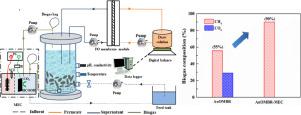Water Research ( IF 11.4 ) Pub Date : 2020-11-27 , DOI: 10.1016/j.watres.2020.116679 Tianyu Gao , Hanmin Zhang , Xiaotong Xu , Jiaheng Teng

|
It has been reported that anaerobic osmosis membrane bioreactors have the potential for energy recovery since dissolved methane was almost rejected by commercial forward osmosis membranes. Notwithstanding, upgraded biogas has to be achieved by removing as much carbon dioxide as possible. In this study, a novel anaerobic osmotic membrane bioreactor-microbial electrolysis cell (AnOMBR-MEC) system was developed for simultaneous biogas upgrading and wastewater treatment. The AnOMBR-MEC elicited an excellent and stable soluble chemical oxygen demand and phosphorus removal. As the experiment progressed, unwanted carbon dioxide produced from biogas was reduced to formate using a SnO2 nanoparticles electrocatalytic cathode in an electrocatalytic-assisted MEC, with the highest faradic efficiency of formate being 85% at 1.2V. Compared to AnOMBR, the methane content increased from 55% to 90% at the end of operation and methane yield experienced a1.6-fold increment in the AnOMBR-MEC. Microbial community analysis revealed that hydrogenotrophic methanogens (e.g. Methanobacterium and Methanobrevibacter) converted the produced H2 and formate to methane at saline conditions. These results have demonstrated an efficient strategy based on the integration of an electrocatalytic-assisted MEC into AnOMBR for upgrading biogas, enhancing methane yield and wastewater treatment.
中文翻译:

将基于电化学二氧化碳还原的微生物电解池集成到厌氧渗透膜反应器中以提高沼气
据报道,厌氧渗透膜生物反应器具有能量回收的潜力,因为溶解的甲烷几乎被商业正向渗透膜所拒绝。尽管如此,必须通过去除尽可能多的二氧化碳来实现沼气的升级。在这项研究中,开发了一种新型的厌氧渗透膜生物反应器-微生物电解池(AnOMBR-MEC)系统,用于同时进行沼气升级和废水处理。AnOMBR-MEC引发了出色且稳定的可溶性化学需氧量和除磷效果。随着实验的进行,使用SnO 2将沼气产生的多余二氧化碳还原为甲酸电催化辅助MEC中的纳米颗粒电催化阴极,甲酸的最高法拉第效率在1.2V时为85%。与AnOMBR相比,操作结束时甲烷含量从55%增加到90%,并且AnOMBR-MEC中甲烷的收率增加了1.6倍。微生物群落分析表明,在盐分条件下,氢营养型产甲烷菌(例如,甲烷杆菌和甲基溴化细菌)将产生的H 2和甲酸盐转化为甲烷。这些结果表明,基于将电催化辅助的MEC集成到AnOMBR中的有效策略,可用于升级沼气,提高甲烷产量和废水处理。











































 京公网安备 11010802027423号
京公网安备 11010802027423号